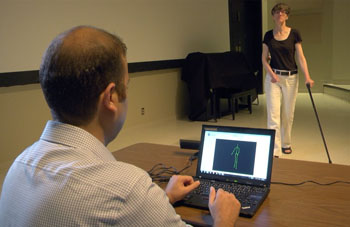Interactive Video Gaming Device Could Aid MS Patients
By LabMedica International staff writers
Posted on 23 Aug 2016
A commonly used 3D depth-sensing camera could become a low-cost means of monitoring treatment effectiveness for walking difficulties of patients with gait-impairing diseases such as multiple sclerosis (MS).Posted on 23 Aug 2016
The Microsoft “Kinect” motion-detection camera can be hooked up to an Xbox gaming console or a Windows computer for interactive video activities such as tennis and dancing. A team of researchers led by McGill University (Montreal, Quebec, Canada) postdoctoral fellow Farnood Gholami, supervised by Prof. Jozsef Kövecses, collaborated with Daria Trojan, physiatrist at the Montreal Neurological Institute and Hospital, to test whether the Kinect could detect the differences in gait of MS patients compared to healthy individuals. The tool could be useful “to assess treatment effects of certain interventions such as rehabilitation or medication, and to document MS disease progression as reflected by gait deterioration. It may also be useful as a measure in clinical trials,” said Trojan. Additional collaboration was with Behnood Gholami at AreteX Systems Inc. (Hoboken, NJ, USA) and Wassim M. Haddad at Georgia Institute of Technology, (Atlanta, GA, USA).

Image: Using Kinect motion-capture camera may improve evaluation of gait pathology in multiple sclerosis patients by increasing objectivity in diagnosis and treatment monitoring (Photo courtesy of the Montreal Neurological Institute & Hospital and McGill University).
In current clinical practice, the walking movement of MS patients is usually assessed by their doctors using subjective evaluations that may distort results such that different clinicians may give different evaluations for the same patient. Using computer algorithms that quantify patient walking patterns detected by a camera can reduce potential for human error.
Using Kinect, Dr. Gholami captured the movement of 10 MS patients and 10 members of an age-and-sex-matched control group. The MS patients had previously been assessed for gait abnormalities using the traditional clinician method. Using the data, the team then developed computer algorithms that quantified gait characteristics of MS patients and healthy people. They found that gait characteristics measured with the Kinect camera and analyzed with the developed algorithms were reproducible when assessed at one visit and were different between MS patients and the healthy individuals. Moreover, the gait characteristics of MS patients obtained by the algorithm were correlated with clinical measures of gait. In addition, the algorithms could mathematically define the characteristics of gait in MS patients at different severity levels, accurately determining the level of gait abnormality.
Dr. Gholami became interested in using motion-capture technology for clinical purposes as a PhD student, but the equipment he was using at the time was very expensive, difficult to use, and non-portable, making widespread clinical use prohibitive. Kinect is an inexpensive tool that appears to be accurate enough to do the job. “This tool may help the clinician provide a better diagnosis of gait pathology, and may be used to observe if a prescribed medication has been effective on the gait of the patient or not,” he said, “Our developed framework can likely be used for other diseases causing gait abnormalities as well, for instance Parkinson’s disease.” The next step is to conduct a study with a larger group of MS patients, including evaluation in a gait laboratory, using a newer version of the Kinect device to improve accuracy.
The study, by Gholami F et al, was published July 21, 2016, in the IEEE Journal of Biomedical and Health Informatics.
Related Links:
McGill University














